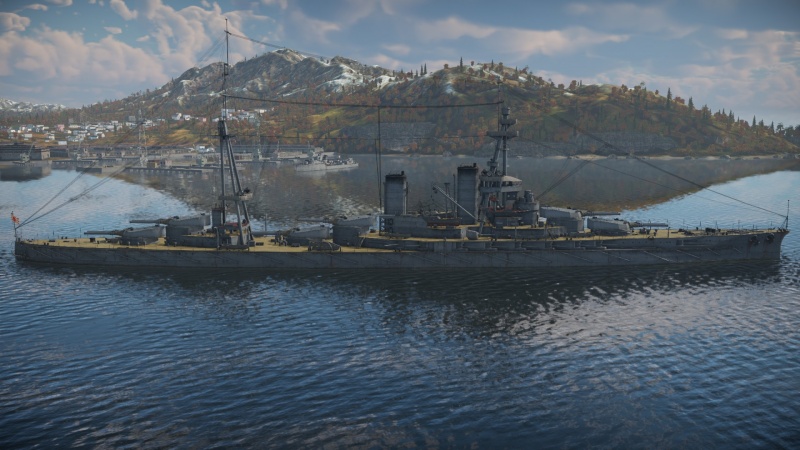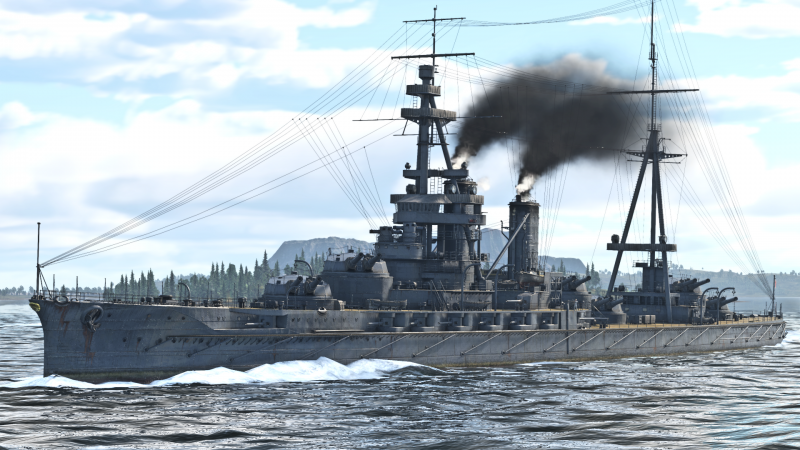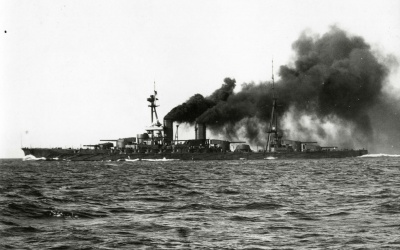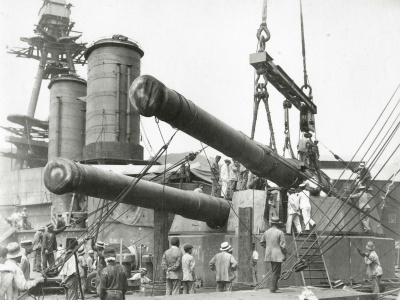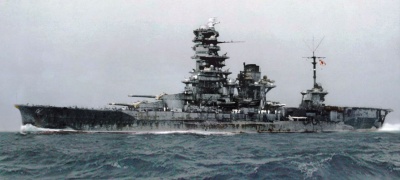IJN Hyuga
Contents
Description
IJN Hyuga (日向, namesake: Hyūga (old) Province) is a battleship of the Imperial Japanese Navy and the second vessel of the Ise class. Commissioned after the end of the First World War, the battleship saw limited action during her service. Notably, she supported Japanese troops during the Siberian Expedition in the Russian Civil War, assisted survivors of the Great Kanto Earthquake, and participated in several battles of the Pacific War during the Second World War. Hyuga was sunk during an American air raid on Kure in July 1945 and was subsequently raised and scrapped in 1946–47.
Introduced in Update "Hot Tracks", Ise-class, IJN Hyuga, 1920 features an excellent main battery supported by a capable secondary anti-surface armament. However, she struggles with anti-air defences, which can, at best, be described as symbolic, to the point that they would struggle to counter even early inter-war bombers. Her armour protection is average, if not below average for her battle rating, making direct engagements challenging. The vessel is equipped with torpedoes that have an 8 km range, with three tubes on each side of the ship, but as they are fixed, their use is highly situational and should not be relied upon.
General info
Survivability and armour
Hyuga's armour will protect you from almost everything except other battleships and Admiral Graf Spee's AP ammunition. Continuous fire from multiple light cruisers will whittle down your crew, but a single well placed salvo from the heavier ships will regularly detonate your magazines, especially the second turret from the front as its magazine is above the waterline. This often will cost you your vessel. Angling your armour is important so it is advisable to angle as much as possible, even if it means losing the front middle turret's ability to fire. A good amount of crew will keep you alive for quite a while. Torpedoes can devastate the ship especially the Japanese long lance variety. Be sure to make constant course corrections in between salvoes when at medium to close ranges from the enemy. Hyuga can survive many bombs hits unless the bombs exceed 1,000 kg in weight. Damage control should focus on fire and flooding. Repair should be secondary as your turrets and guns are very strong. Many enemies will try to "revenge bomb" you so always try to keep close to decent AA ships. The lacklustre anti-air armament on the ship means planes can fly circles around you at very close range without threat from your ship.
Mobility
With a top speed of 23.7 kn, Hyuga is not a fast ship, but for battleship standards, she is at the faster end. Do not rely on the mobility to avoid incoming fire. Manoeuvres need to be planned in advance and the slow turning rate will cost you minutes of reversing and turning to correct mistakes such as running aground in tight spaces. It is best to avoid tight spaces in general.
| Mobility Characteristics | |||
|---|---|---|---|
| Game Mode | Upgrade Status | Maximum Speed (km/h) | |
| Forward | Reverse | ||
| AB | |||
| Upgraded | |||
| RB/SB | |||
| Upgraded | |||
Modifications and economy
While stock, the Hyuga is already a monster of a ship that simply needs some basic modifications to fully get going, start with the basic Tool Set & Fire Protection System to increase survivability. Afterwards aim towards the APC shells, which will be required to target other battleships and battlecruisers more efficiently.
After the basics, the captain can choose modifications to their own discretion, either increase seakeeping for mobility in enduring confrontations, unsinkability in case crew damage seems too high, and firepower in case target acquisition doesn't happen soon enough.
Armament
Primary armament
Bolstering 12 x 14-inch guns, the Hyuga dishes out a very high payload per salvo. The ship on the receiving end of such firepower will most definitely get major damage or ammo rack detonations.
As any other capital ship, the shell priority goes as follows:
- SAP - Anything smaller than a CA should sink the moment a full salvo of SAP hits the ship.
- APC - Primarily used for BCs & BBs (and heavily-armed CAs), try to aim for ammo storage to deal a crushing blow to the enemy vessel.
| Penetration statistics | |||||||
|---|---|---|---|---|---|---|---|
| Ammunition | Type of warhead |
Penetration @ 0° Angle of Attack (mm) | |||||
| 1,000 m | 2,500 m | 5,000 m | 7,500 m | 10,000 m | 15,000 m | ||
| Ordinary SAP | SAPCBC | 301 | 280 | 248 | 222 | 199 | 168 |
| 3rd Year Type APC | APCBC | 607 | 564 | 500 | 447 | 402 | 338 |
| Shell details | ||||||||||||
|---|---|---|---|---|---|---|---|---|---|---|---|---|
| Ammunition | Type of warhead |
Velocity (m/s) |
Projectile mass (kg) |
Fuse delay (s) |
Fuse sensitivity (mm) |
Explosive mass (TNT equivalent) (kg) |
Ricochet | |||||
| 0% | 50% | 100% | ||||||||||
| Ordinary SAP | SAPCBC | 780 | 635.58 | 0.01 | 26 | 68.64 | 48° | 63° | 71° | |||
| 3rd Year Type APC | APCBC | 780 | 635.58 | 0.05 | 26 | 13.31 | 48° | 63° | 71° | |||
Secondary armament
Armed in 18 casemates and 2 gun turrets, the 140 mm cannons provide the Hyuga with good in-between main salvo firepower, loading at 6 seconds with SAP, which can be used to destroy lighter vessels with ease as 10 guns are usually full broadside aimed at said vessel and ranging for the main guns. They also dish out considerable chip damage on light & heavy cruisers, usually resulting in fires and crew losses that will start dwindling the longer the guns keep firing on them.
| Penetration statistics | |||||||
|---|---|---|---|---|---|---|---|
| Ammunition | Type of warhead |
Penetration @ 0° Angle of Attack (mm) | |||||
| 1,000 m | 2,500 m | 5,000 m | 7,500 m | 10,000 m | 15,000 m | ||
| Mod 1 SAP | SAPBC | 115 | 100 | 81 | 65 | 54 | 40 |
| Shell details | ||||||||||||
|---|---|---|---|---|---|---|---|---|---|---|---|---|
| Ammunition | Type of warhead |
Velocity (m/s) |
Projectile mass (kg) |
Fuse delay (s) |
Fuse sensitivity (mm) |
Explosive mass (TNT equivalent) (kg) |
Ricochet | |||||
| 0% | 50% | 100% | ||||||||||
| Mod 1 SAP | SAPBC | 855 | 37.87 | 0.05 | 6 | 2.21 | 48° | 63° | 71° | |||
Anti-aircraft armament
As a 1920s battleship, the anti-aircraft defense wasn't a big concern and hence why the IJN Hyuga has a lacklustre defense against aerial attacks with only 6 Lewis guns spread out across the ship. While very unlikely, planes making a very slow pass and getting within a few hundred metres of the ship might catch some bullets and potentially get shot down.
Additional armament
With the Hyuga being an old ship, she carries the old mentality of requiring torpedoes to provide additional broadside firepower. In reality, torpedoes would be utterly useless considering the main guns outrange these. And if a ship were to come this close, something wrong must have happened. It's advised to simply not equip the torpedoes as they're more of a liability and additional explosive mass to the ship if they were to get hit.
Usage in battles
As a battleship, the Hyuga can take and deal quite a beating with her powerful 12 x 356 mm guns that will blow most ships out of the water with a full salvo. With a shell output of 2 RPM (per cannon), there still be a good bit of downtime in between large salvoes, which can be filled in with the casemate 140 mm that come with SAP shells on the ready that can cripple DDs, CLs and lightly armoured CAs on-top of the 10 RPM fire-rate.
There are 2 target classes the captain needs to take into account when sailing out the Hyuga
- Against BCs & BBs
If the Hyuga encounters other battleships and battlecruisers, start loading AP and aim below the main guns into the ammo rack, disposing of them as efficiently as possible, in between salvos try to angle the ship or use cover to protect Hyuga's own ammo racks from exploding as they're unlike most battleships, above the water line and very exposed to a single plate of 54 mm.
Using the casemate guns can be used to widdle down the crew on the deck of the battleship or start fires, but a confident captain uses them to engage a different target.
- Against anything else
If no-other battleships are present, load SAP and single salvo on CAs and systematically start sinking the enemy fleet before all guns start training onto the Hyuga, most ships will go down in a single salvo with a good aim and if not, will be crippled beyond repair and become a sitting duck to finish her off with the casemate secondaries.
Try to prioritize the heaviest of ships and keep dishing out SAP until a new Battleship or Battlecruiser arrives to the scene. Depending on how far the next salvo is loaded, wait until the cannons are fully loaded before switching shells if it's further than half loaded to deal one more blow to light targets before preparing a salvo on the bigger fish.
Pros and cons
Pros:
- War Thunder's first super-dreadnought; armed with 2 by 6, 14-inch cannons
- Can all be fired broadside
- Armour value is overall 305 mm to 203 mm
- 20 x 140 mm (5.5 inch) secondary cannons
- 6 seconds reload per gun on Ace crew
- Great solution for anything lighter than a cruiser
- Amazing shell choice
- HE: 68 kg of TNT equivalent which can decimate anything lighter than a BB with a single volley
- Best to be only used on CLs & CAs
- APC: 620 mm of penetration (range of 1,000 m), being the highest penetration value among BBs
- Best to be only used on other BBs
- HE: 68 kg of TNT equivalent which can decimate anything lighter than a BB with a single volley
Cons:
- Poor AA; six single Lewis machine guns (7.7 mm)
- Ammo and magazines for "A" turret are only protected by a single 56 mm plate
History
IJN Hyuga was the second ship of the Ise class, a class of two Japanese super-dreadnoughts built for the Imperial Japanese Navy. As the third class of dreadnoughts designed for the Japanese Navy (after the preceding Fuso and Kawachi classes), Hyuga mounted an extremely powerful main battery. She was commissioned too late to serve in the First World War, but saw service in the interwar period including some minor roles during the Second Sino-Japanese war. Hyuga was extensively modernized before the start of the Second World War, but remained obsolete. As a result, she saw little combat action. In 1943, Hyuga was given a heavy refit, and the rear guns were removed to make way for a spacious flight deck for seaplanes. She was eventually sunk by American carrier aircraft in 1945 at Kure, and was scrapped between 1946 and 1947.
Design and development
In 1906, the Japanese navy was given a very rough jolt when the British launched the HMS Dreadnought, the first dreadnought battleship. The advent of dreadnoughts had made all existing Japanese capital ships obsolete, and as a result, the Japanese began an ambitious shipbuilding program. Two ships of the Kawachi-class were built, followed by two ships of the Fuso class. Initially, just a single Fuso-class ship was ordered, but after the Japanese Diet approved more funding, three more ships were ordered - Yamashiro, Ise and Hyuga.
However, following the launch and completion of Fuso, the Japanese found that the design had several flaws. Namely, the central-mounted 12-inch guns complicated gun loading, and the 6-inch secondary guns had fire rate problems due to their manual loading. Thus, the Japanese navy developed a new design that would become the Ise class.
Visually, Hyuga looked very similar to the previous Fuso class, and had the same main battery of twelve 14-inch (356 mm) guns in six dual mounts. However, the turrets were rearranged, mounted in a similar layout as the American Wyoming-class. Two turrets were mounted in a superfiring pair forward of the superstructure, while another pair was located at the aft. Finally, the third pair was located facing backwards between the fore and rear masts. Hyuga also carried twenty 5.5 inch (140 mm) guns in single mounts, 10 per side. She carried four 7.7 mm machine guns for AA defence, as well as six 533 mm torpedo tubes. Hyuga was able to make 23 knots (41 km/h), making her faster than her American and British counterparts.
Hyuga was laid down in May of 1915, four days before her sister-ship Ise was laid down. She was launched in January of 1917, and completed in April of 1918. Upon her completion, Hyuga, along with her sister ship Ise, were assigned to the first Battleship squadron of the Japanese First Fleet.
Interwar years
Hyuga was commissioned too late to see service during the First World War, but immediately began serving with the First Fleet upon her completion. Immediately after her completion, Hyuga had a turret explosion that killed 11 men; soon after, she collided with a schooner. Despite this rather poor introduction, Hyuga served extensively with the First Fleet and sailed on several cruises in the East China Sea, and north towards the Soviet Union. Following the Kanto earthquake of 1923, she loaded and transported supplies for earthquake victims. In 1928, she received a minor refit and gained a new, larger superstructure. She patrolled the Chinese coast following the Shanghai incident, and later performed patrol duties during the Sino-Japanese war.
In 1936, Hyuga received a full refit, and was fitted with her large pagoda mast. This refit increased her full load weight by almost 6,000 tons, from 36,500 to 42,200. She was fitted with a full steam turbine propulsion system increasing her speed to 24.5 knots, and she received her first set of anti-aircraft defenses comprising several dual 5-inch (127 mm) DP guns and ten dual 25 mm AA gun mounts. She later served as the flagship of Puyi, the Japanese-installed emperor of the puppet state of Manchuria, during his visit to Japan in 1940.
Service during the Second World War
Hyuga served as part of the cover for the first Carrier Fleet during the Pearl Harbour attack, and later attempted to intercept the USS Hornet after she launched the aircraft of the Doolittle Raid. In early 1942, Hyuga suffered an explosion in her No. 5 turret that killed over 50 crew members and caused severe damage to the turret - it was removed, the barbette covered with an armour plate, and additional 25 mm AA guns were installed in its place. Hyuga later served as part of the force covering the Japanese carrier fleet attacking Midway atoll.
Following the catastrophic loss of four Japanese fleet carriers at Midway, the Japanese were in dire need of additional aircraft-carrying ships. Because of the enormous cost of completely rebuilding a battleship into an aircraft carrier, the decision was made to rebuild Ise and Hyuga into hybrid battleship-carriers. The ships had their No. 5 and No. 6 rear turrets removed (though Hyuga's No. 5 turret had already been destroyed in the explosion), replaced with a massive flight deck and hangar. Because the flight deck was too short to support carrier landings and takeoffs, Hyuga was fitted with two aircraft catapults. She was designed to carry an air group of 22 aircraft, including D4Y Suisei dive bombers (which had to land on a carrier or a land base) and E16A Zuiun reconnaissance seaplanes (which could be recovered). She also received a formidable anti-aircraft armament composed of 104 x 25 mm guns in 31 triple and 11 single mounts, as well as several anti-aircraft rocket launchers.
It was in this configuration that Hyuga sailed in June of 1943 as the flagship of the Japanese 4th Carrier division. She saw extensive combat action during the battle of Leyte Gulf, where she provided anti-aircraft cover for Japanese cruisers. She was attacked by a force of 125 American carrier aircraft, but suffered little damage as she was not targeted.
In February of 1945, Hyuga transported a large amount of critical war materials back to Japan with her sister Ise and the light cruiser Oyodo. After being pursued by numerous American submarines, they arrived in Japan in early March. Hyuga was thereafter reduced to reserve, and served as an advanced training ship, moored in Hiroshima bay. In late March of 1945, she was heavily damaged by an allied air raid on Kure; most of her anti-aircraft and secondary mounts were removed for shore defence. In July, she was severely damaged again during the bombing of Kure; hit by 10 bombs, she was abandoned and later sank to the bottom of the harbour. After the war, she was raised, and scrapped by 1947.
Media
- Skins
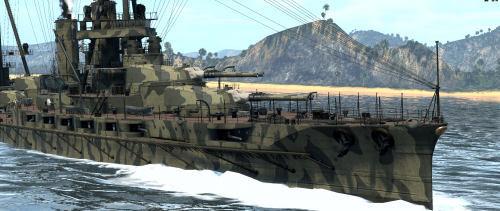
- Videos
See also
Links to articles on the War Thunder Wiki that you think will be useful for the reader, for example:
- reference to the series of the ship;
- links to approximate analogues of other nations and research trees.
External links
References
- Chen, C. (n.d.). Battleship Hyuga. Retrieved January 03, 2021, from https://ww2db.com/ship_spec.php?ship_id=29
- Hackett, B. (1997). IJN Hyuga: Tabular table of movement. Retrieved January 03, 2021, from http://www.combinedfleet.com/Hyuga.htm
- Naval Encyclopedia. (2019, September 14). IJN Battleships Ise and Hyuga (1917-1945). Retrieved January 03, 2021, from https://www.naval-encyclopedia.com/ww2/japan/ise-class-battleships
| Mitsubishi Shipbuilding Company Ltd. | |
|---|---|
| Light Cruisers (CL) | |
| Kuma-class | IJN Tama |
| Sendai-class | IJN Sendai |
| Mogami-class | IJN Mikuma |
| Heavy Cruisers (CA) | |
| Furutaka-class | IJN Furutaka |
| Aoba-class | IJN Aoba |
| Myōkō-class | IJN Haguro |
| Tone-class | IJN Tone |
| Battleships (BB) | |
| Ise-class | IJN Hyuga |
| See also | Mitsubishi Heavy Industries, Ltd. (Post-War) |
| Japan battleships | |
|---|---|
| Kawachi-class | IJN Settsu |
| Fusō-class | IJN Fuso · IJN Yamashiro |
| Ise-class | IJN Ise · IJN Hyuga |
| Kongō-class | IJN Kongo · IJN Haruna |
| Nagato-class | IJN Mutsu |



